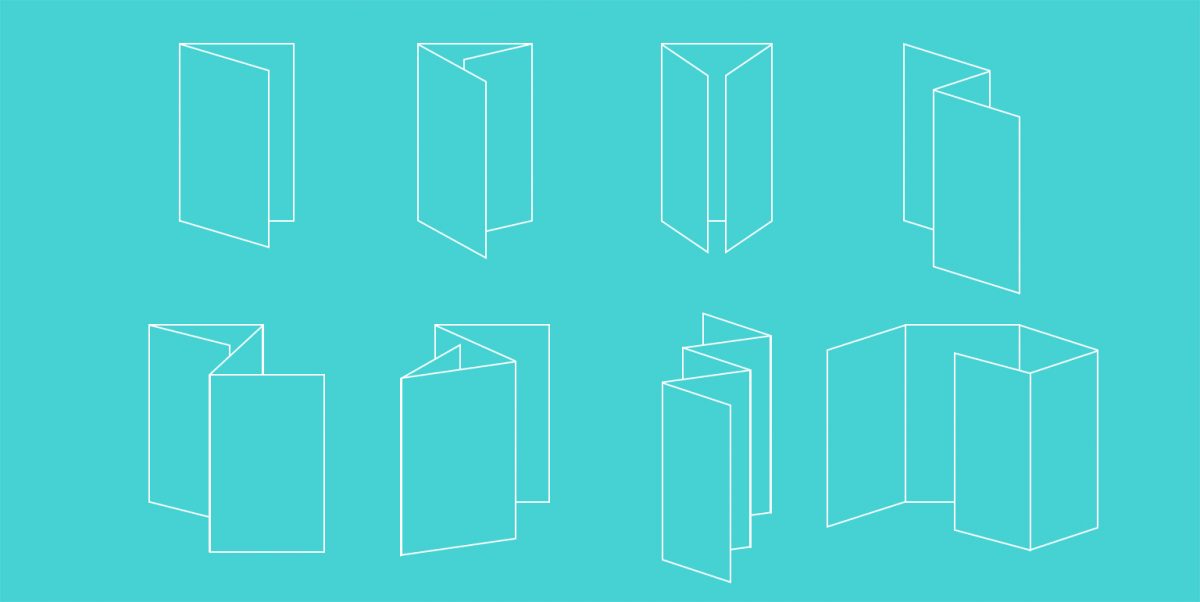As a graphic design business that specialises in brochure design, one of the conversations that we regularly find ourselves having with clients concerns the form that their printed brochure might take and how it might be folded. Fold types can be very effectively used to gain more interest, to better support the main selling proposition, or to simply sidestep the norm.
So, to help ourselves as well as to provide a handy reference guide for our clients, we’ve gathered together a selection of the most popular fold types used for printed documents with four, six, eight, ten and sixteen pages as a convenient list for anyone considering sales leaflets, brochures, direct mailers or newsletters.
The Half-fold, also known as the single fold or book fold, is mainly used for brochures and newsletters, and works well in both landscape and portrait formats. The most common instances are as A4 portrait brochure, opening up to a landscape A3 size, but it can be used at many varied sizes and is still most commonly seen in newspapers.
The classic Tri-fold, also known as a letter fold, roll fold or c-fold creates a six panel format and presents a great, compact document with good surface areas both inside and out, making it easy to read and fold back together again. These are particularly effective because the three-page centrespread provides a great space with which to communicate your key messages and make serious impact. We often consider ‘the larger the better’ and these work really well at A4 portrait size (when folded), but can be commonly seen at DL size (folded) which opens out to a horizontal A4 sheet of paper. The outside right panel can often be used to great effect too with a sales proposition or conceptual focal point, or by trimming the front cover right edge to reveal some of this page, which sits beneath the cover when folded.
Roll folds can be also be effectively used for eight, ten or more pages if desired, as can the below z fold. Having more pages enables these types of documents to carry more text or communicating info heavy designs so are perfect for promotional leaflets, programs, tutorials and step by step instruction guides.
The Z fold, also known as a zig-zag, fan fold or accordion fold is simply a different way of scoring and folding a tri-fold. Instead of folding the third panel in from the right, it’s folded out, making a z shape with the top edge. It is commonly used for flyers, mailouts and brochures, and of course for folding letters so that they fit into a DL envelope.
Die-cut z fold. Take the flat z fold artwork, cut a horizontal angle from left to right and then fold it together to create a document with an angled front panel which is shorter in height than the middle and back panels. Simple difference, great impact.
The Gate fold, double fold or window fold format is perfect for graphically-heavy designs. Gate folds also create a six-panel document but, with the two outer panels being narrower than the central panel, the format presents a brilliant way to tee-up then present the message by the reader having to open up the document like a pair of saloon doors.
Double gatefold brochures constitute four panels, so eight pages. The two ends of the sheet are folded to meet in the middle, and the document is then folded in half again. They are ideal for large presentations and for small format product sales brochures or catalogues with limited but numerous products.
Double Parallel folded documents have four panels, which creates eight pages. Whilst they may sound confusing, the quite simply consist of an often wide and short flat rectangular sheet, which is first folded in half, and then in half once again in the same direction.
French folds are made by folding a sheet in half vertically, and then horizontally. The two folds create eight panels, four on the front and four on the back. This enables a document which when folded is the size of a booklet or brochure, which when opened expands to a final size that feels like a poster. This format is most commonly seen with maps and charts, and can be used to great effect with newsletters or for promotional items for where many individual products or events need to be included.
We hope that you now feel fold-enlightened but if you still have questions about a format that we haven’t explained – think origami – we’re only too happy to help, so drop us a line or call to discuss.


